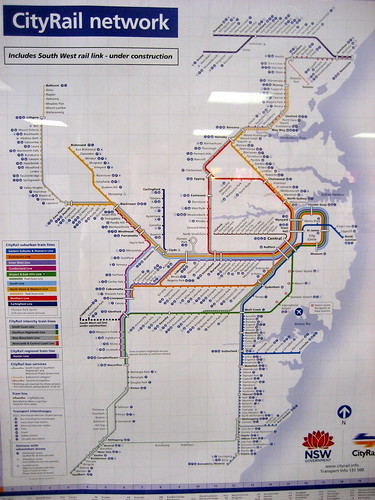It is an enormous project with an massive price tag for any State Government. That said, it is one of those projects that just has to happen if Sydney is going to handle its population growth in a sustainable, sensible way.
The problem is less obvious when you view the Sydney train map as we usually see it:
Of course, the train map looks nothing like that in real life:
 |
| Picture from Wikipedia |
That map is taken from Labor's Metropolitan Transport Plan. The most important things to note are the North West and South West Growth Centres.
The government has asked all local councils to accept additional residents by rezoning. Those that cannot be fit into present developed areas will have to go somewhere.
Of course, whether Sydney should be allowed to grow in this way is another discussion that should be had, but lies somewhere beyond the scope of this post.
It is pretty obvious that the South West Rail link will be needed to service the South West Growth Area. The route can be seen on this map, marked in black on the bottom left, and it is expected to be completed in 2016:
The North West Rail link is not only needed to service the North West Growth Area, but also to give people in the North West an option for getting to the city other than the M7, M2, and Lane Cove Tunnel.
Driving to the city from these areas is very expensive, which would not be a problem if there was a reliable, frequent, late-running train service, which of course there is not.
The other obvious gap in the map is the train line to the northern beaches, but that appears to be off everyone's radar at the moment.
I had planned to write here about the long history of rail lines promised for the North West, but franly the history is too sordid and confusing. Suffice to say that if you would like to be walked through the Labor Government's inablity to accomplish anything substantive in this area then the Wikipedia will explain it all.
Of course, Labor did deliver the Chatswood-Epping connection. That said, this was originally meant to be the Parramatta-Chatswood connection, and was completed at a cost way above the original budgeted cost for the Parramatta-Chatswood plan.
The problem is not of O'Farrell's making. In fact, the Labor government that preceded his is not entirely to blame either. Bradfield laid the plans for Sydney's train system. The plans were visionary - the problem is that over 100 years later Sydney has outgrown those plans.
 |
| Sydney's train lines in the late 1800's |
Of course, as history shows, the Labor government's fixation on roads meant we now have a pretty good road system. Admittedly it costs a bit to use it, but we got roads that the government could never afford to have build (or so they say). I, for one, have no trouble with a portion of user pays on our roads.
By contrast, train lines will inevitably need to be subsidised by the government as commuters will usually not pay enough to cover costs.
But train lines offer a potential for growth that roads do not. One only need to look at cities like Los Angeles to see the consequences of failing to provide good, efficient and affordable public transport.
Buses, especially in the North West and the Northern beaches have partially filled the void. But buses have a limited capacity - many people avoid them because they are irregular, unreliable, and often stop running an inconvenient times.
This story published today in the SMH that the planners are reconsidering the location of the stations.
This is appropriate - whilst I have no doubt that many people have been complaining about the time it is taking to "turn the first sod", it is essential that a little time be taken to get things right the first time.
A well planned, efficient train system is vital to a thriving city - and this process is part of planning things out in a sensible fashion.
As someone who works in the Sydney CBD and catches the train every day, I shudder to imagine what Sydney would look like if we did not have the train system that we do.
But train systems require constant re-investment if it is to cope with the inevitably uneven population growth.
For decades now Sydney has not had the benefit of decisive planning and investment in the train system. If O'Farrell really does achieve his stated objective of being the infrastructure premier, then Sydney will have the benefit of his political courage for decades to come.
If not, then he will join a long list of premiers who promised big and failed to deliver.



No comments:
Post a Comment